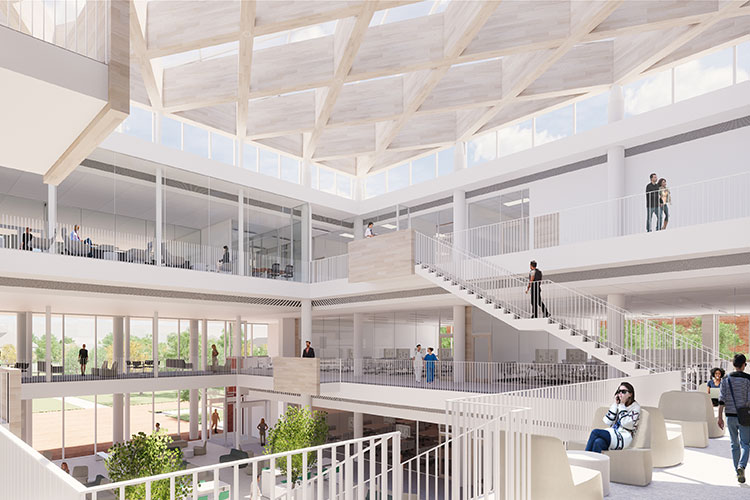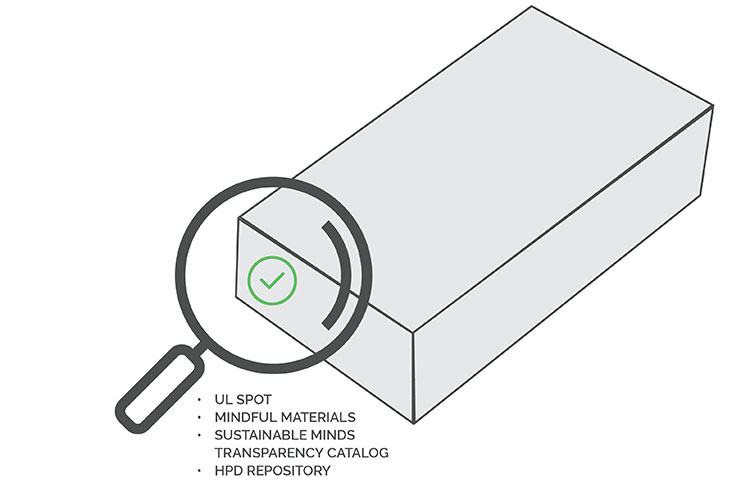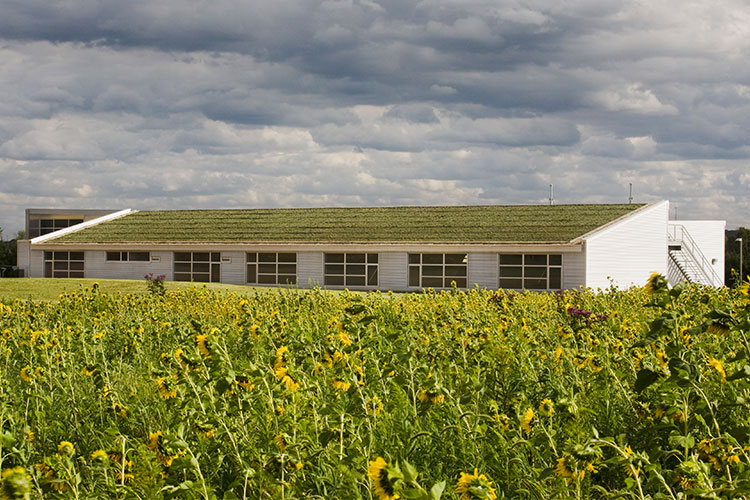The pandemic is a stark reminder that the natural world is always present, always powerful, and must be respected as built environments continue to expand. Here are ways to find healthier products for any project.
By: Bob Stroup, AIA, WELL AP, CDT, NCARB, LEED AP // Project Architect
Sustainability is not a choice. At some point, at some level, if projects are not sustainable, they do not effectively contribute to their surrounding environment in a constructive way. It’s not enough to provide active ventilation within an interior environment. The site on which the building is developed needs to respond to environmental needs as well. To borrow the immortal words of poet John Dunne, no building, just as no human, is an island.
And just as “every man is a piece of the continent,” every project is a part of a neighborhood. And every neighborhood in turn a part of a city. Everything is interconnected regardless of degree, and sustainable design is the modern equivalent to addressing the necessity for universal connectivity.
In the wake of COVID-19, every effort to incorporate sustainability should be considered. Because humans have developed over half of the world’s land, the likelihood of additional pandemics in the not-so-distant future increases. Animals, without homes, draw closer to our civilizations and cohabitation becomes increasingly likely. Zoonotic diseases, such as West Nile Virus and Ebola, transfer from animals to humans, and most outbreaks in the world are a result of this process.
Over the past 40 years, this trend has continued to rise; the world, not unlike an immune system, is fighting unchecked development. If we fail to accept sustainability and the fundamental truth that the world is not entirely ours, the earth will trade virus for virus.


As an architecture firm, our obligation is to provide sustainable solutions for our clients. We must evaluate the needs and functions for our spaces in the moment while& keeping one eye on the horizon. Occasionally there are instances where the two priorities for present and future intertwine. Material selection is one of those instances. In projects such as OSU Newark’s McConnell Hall and Bowling Green University’s Moseley Hall, DesignGroup worked closely with the client to identify products that met the required thresholds for regional and recycled products. This, in turn, played no small part in earning LEED Certified and Gold certifications, respectively.

The process of finding healthy products used to be exclusive to designers; it is no longer. Material transparency has become one of the silver linings to sustainable development in the past decade. Manufacturers and suppliers have been pivotal in the development of online resources that help owners and developers select red-list free products before the design process begins. This is knowledge we need now; as active participants in the pandemic, our ability to take an active role in our environs is what will push us through.
Specifying Products by Health
“Is a product healthy?” is the question that underlies most sustainable construction. According to the United States Green Building Council (USGBC), the term “healthy” should be divided into two categories:
- Products that have a proven lifecycle analysis that positively impacts the designed-for environment.
- Products that provide disclosure of a limited potential for off-gassing.
So, where can one go to learn if a product is declared healthy? While material transparency is highly regarded throughout the design and construction industry as a best practice, it is less recognized by owners. In establishing brand standards, very few online databases are available which seems like a potential oversight by those seeking a higher standard for sustainability. Fortunately, in the past half-decade there have been significant advances online to make it easier for consumers to find sustainable materials. The time has come for clients to leap in and learn.

Where to Go
There are several websites that handle material transparency well, but only a select few handle certifications and declarations efficiently. Some databases employ a more detailed approach: they categorize products by filtering products that are “red-list free,” meaning that a product meets VOC standards and other off-gassing requirements established by standards such as SCAQMD 1113 or 1168. Other databases provide lists of manufacturers directly; by selecting a manufacturer, one begins to understand what types of certifications the supplier/vendor is working to achieve. This establishes a wider range of client comprehension; with this knowledge, a client may seek a manufacturer before seeking the product. Ultimately, it may be better to focus less on individual certification and more on raising the overall material health of a project. Here are a few examples of websites that allow for a broader approach:

- UL SPOT With more than 50,000 products, UL Spot is widely considered a go-to in both design and development industries. Products are searchable by LEED credit, manufacturer, product type, certification program and CSI division. Certification programs that can be filtered include GREENGUARD, ECOLOGO, Cradle-to-Cradle, BIFMA level, Green Label Plus and others. Documents and certifications are downloadable and are continually kept updated by UL. Searches can be saved, and a collaborative work environment can be set up through features that enable team members to share information.
- To meet materials and resources credit requirements for Columbus State Culinary Center, DesignGroup used UL Spot to identify products that were declared and red-list free. UL Spot provided invaluable documentation that was then uploaded to LEED Online which proved useful during the construction credits LEED submission process.
- Mindful Materials This site is frequently cited by interior design representatives as a one-stop-shop for locating sustainable and healthy finish materials. With over 8,200 products and 170 manufacturers, Mindful Materials is a finish-friendly resource developed by the building industry for improving product transparency. As part of the vision established by GIGA’s platform Origin, Mindful Materials showcases products in a digital library that allows manufacturers to manage product information directly, keeping certifications and new features for products up-to-date and readily available for all potential users. All products listed must meet one of the following listed baseline criteria:
- Emissions testing held to widely recognized standards
- Materials ingredients disclosed through manufacturers or third parties
- Environmental profiles published with life-cycle analysis reports meeting ISO/EN standards
- Material sourcing using eco-friendly management best practices
- With similar filters to that of UL Spot, Mindful Materials can single out products that meet specific user requirements. An easy way to determine if your company or organization is meeting international sustainability standards for finishes is to verify specified products with this online resource or a similar platform (such as UL Spot). If not listed on either website, while an item may still prove green, it may not contribute toward a desired certification.
- Sustainable Minds Transparency Catalog This resource that makes it easy to locate and specify green products. The manufacturer-based database works to eliminate the extra work designers and owners spend searching for LEED and WELL compatibility.
- The site offers product category rules (PCRs) set up per CSI MasterFormat section. If a product from a preferred manufacturer is not available, the design team can reach out to the supplier and notify them of the PCR to properly declare a product. This helps establish transparency from all levels within the building industry and helps manufacturers/vendors to provide the best products possible with sufficient visibility.
- HPD Public Repository The HPD Public Repository provides health product declarations. HPDs are more specific in terms of formation than EPDs, which can be provided by third parties or through manufacturers and can be product-specific or industry-wide. By presenting continuously updated information with a quick search feature, HPD Collaborative’s Repository goes a long way in securing LEEDv4.1 Building Product Declaration Optimization: Material Ingredients credits, in addition to optimizations for WELL materials.
What Kinds of Products Should I Look For?
There is an endless supply of products that can contribute to the overall health of a building. These websites do not limit products to interior/exterior, building or landscape – rather, products are listed using an integrative approach and include all categories where products can count for certification. Some products that can be found include:
- Adhesives/Sealants
- Bedding
- Cabinetry
- Ceiling Systems
- Cleaning Products
- Countertops
- Electricity
- Flooring
- Furniture
- Hardware
- Insulation
- Paints/Coatings
- Plastics
- Prefabricated Panels
- Primers
- Sanitary Papers
- Specialty Equipment
- Surfacing Materials
- Textiles
- Toilet Accessories
- Visual Display Products
- Wall Finishes
- Windows
- Wood Finish Products

How Clients Can Help?
Clients or parties responsible for company standards should work to incorporate, as much as possible, products that meet or exceed international baselines for sustainability and wellness. Those involved with facilities operations have an obligation to provide the highest quality of infection control and safety in the environments they work to create; seeking out better products creates better projects. CEOs and CFOs can act as a control measure by determining the life cycle analysis of any recommended product; without an economic return on investment green products do not meet the triple bottom line.

Not every product is inherently sustainable, and this is acceptable; the health and well-being of a building is not dependent on an individual product. However, the sum of all products’ health, based on cost or volume, will determine whether a building is capable of a desired certification. Before the architect is engaged and/or development begins, seek products out that fit your need, your brand, and your vision with one underlying thought that will always benefit your occupants: “Is the building material healthy?"

Bob Stroup, AIA, WELL AP, CDT, NCARB, LEED AP // Project Architect
With a diverse technical background, Bob has contributed to a vast array of large-scale projects from design through construction. Having worked as an engineer and being a Registered Architect, Bob brings a strong technical skillset and has earned an understanding of what clients and consultants look for from an architect. He excels in product selection, understanding constructibility, implementing sustainable practices and most importantly, working with the client and consultants to deliver the best building possible.
Sources:
- International Living Future Institute - Living Building Challenge - https://living-future.org/
- American Council for an Energy Efficient Economy -
- National Resources Defense Council -
- International Energy Association -
- Green Billion -
- Biophilic Design - https://www.terrapinbrightgreen.com/reports/14-patterns/
